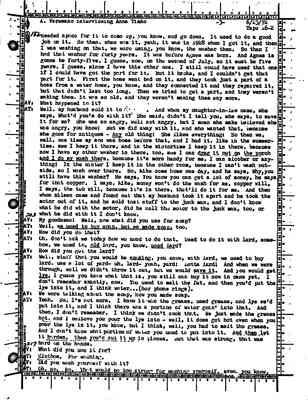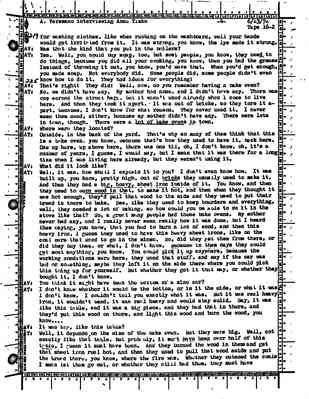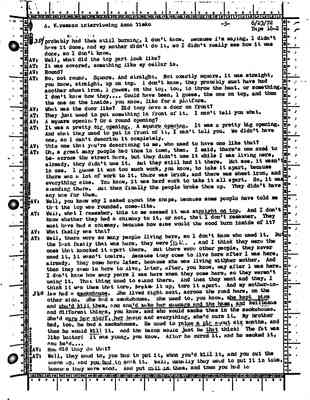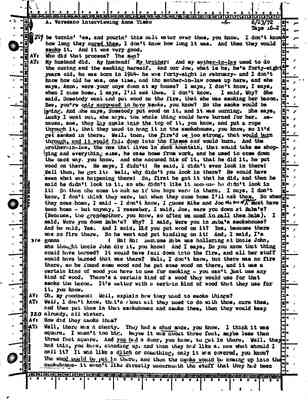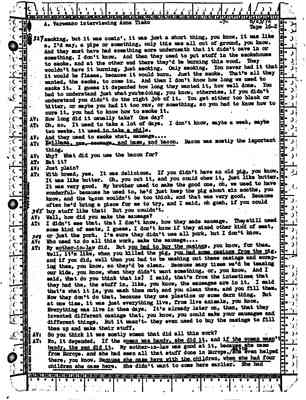Pages
58
A. Varesano interviewing Anna Timko - 3 - 6/23/72 Tape 16-2
needed space for it to come up, you know, and go down. It used to do a good job on it. So then, when was it, yeah, it was in 1928 when I got it, and then I was washing on that, we were using, you know, the washer then. So than I had that washer for forty years. It was before Agnes was born. And Agnes is gonna be forty-five, I guess, now, on the second of July, so it must be five year, I guess, since I have this other one. I still could have used that one if I could have got the part for it. But it broke, and I couldn't get that part for it. First the hose went bad on it, and they took just a part of a hose from a water hose, you know, and they connected it and they repaired it, but that didn't last too long. Then we tried to get a part, and they weren't making then, it was so old, and they weren't making them any more.
AV: What happened to it?
AT: Well, my husband sold it to . And when my daughter-in-law came, she says, What'd you's do with it? She said, didn't I tell you, she says, to save it for me? She was so angry, well not angry, but I mean she make believed she was angry, you know! But we did away with it, and she wanted that, because she goes for antiques - Any old thing! She likes everything! So then we, well, one time my some was home before that, and I had it, like in the summertime, see I keep it there, and in the wintertime I keep it in there, because now I have my other washer in there, too,see I can drag it out on the porch and I do my wash there, because it's more handy for me, I can slobber or anything! In the winter I keep it in the other room, because I can't wash outside, so I wash over there. So, Mike come home one day, and he says, Why, you still have this washer? He says, You know you can get a lot of money, he says for that copper. I says, Mike, money won't do the wash for me, copper will, I says, the tub will, because it's in there, that'll do it for me. And then when Eileen came and found out that my husband took it apart and he took the motor out of it, and he sold that stuff to the junk man, and I don't know what he did with the motor, did he sell the motor to the junk man, too, or 203 what he did with it I don't know.
AV: My goodness! Well, now what did you use for soap?
AT: Well, we used to buy soap, but we made soap, too.
AV: How did you do that?
AT: Oh, don't ask me today how we used to do that. Used to do it with lard, somehow, we used to old lard, you know, used lard?
AV: How did you get the lard?
AT: Well, stuff that you would be cooking, you know, with lard, we used to buy lard, use a lot of yard- uh, lard- yeah yard! Lotta lard! And when we were through, well we didn't throw it out, but we would save it. And you would get lye, I guess you know what that is, you still can but it now in cans yet. I don't remember exactly, now. You used to melt the fat, and then you'd put the lye into it, and I think water...(her phone rings).
AV: We were talking about the soap, how you made soap.
AT: Yeah. So, I'm not sure. I know it was the grease, used grease, and lye we'd put into it, and I think there was a portion of water goin' into that. And then, I don't remember, I think we didn't cook that. We just made the grease hot, and I believe you pour the lye into - well, it does get hot even when you pour the lye in it, you know, but I think, well, you had to melt the grease. And I don't know what portion of water you used to put into it. And then let it harden. Then you'd cut it up in pieces. But that was strong, that was 217 hard on the hands.
AV: What did you use it for?
AT: Clothes. For washing.
AV: Did you wash yourself with it?
AT: Oh, no. No. That would be too strong for washing yourself. Even, you know
59
A. Varesano interviewing Anna Timko -46/23/72 Tape 16-2
219 for washing clothes, like when rubbing on the washboard, well your hands would get irritated from it. It was strong, you know, the lye made it strong
AV: Was that the kind that you put in the boilers?
AT: Yes. Well, you could buy soap, too, but most people, you know, they used to do things, because you did all your cooking, you know, then you had the grease. Instead of throwing it out, you know, you'd save that. When you'd get enough, you made soap. Not everybody did. Some people did, some people didn't even 225 know how to do it. They had ideas for everything!
AV: That's right! They did! Well, now, do you remember having a bake oven?
AT: No, we didn't have any. My mother had none, and I didn't have any. There was one across the street here, but it wasn't used already when I come to live here. And then they took it apart. It was out of bricks, so they tore it apart, because, I don't know for what reason. They never used it. I never seen them used, either, because my mother didn't have any. There were lots in town though. There were a lot of bake ovens in town.
AV: Where were they located?
AT: Outside, in the back of the yard. That's why so many of them think that this is a bake oven, you know, because that's how they used to have it, back here. One up here, up above here, there waw one til, oh, I don't know, oh, it's a number of years, I guess, I would say, but I mean that it was there for a long time when I was living here already, but they weren't using it.
AV: What did it look like?
AT: Well, it was, how shall I explain it to you? I don't even know how. It was built up, you know, pretty high, out of bricks they usually used to make it. And then they had a big, heavy, sheet iron inside of it. You know, and then they used to burn wood in that, to make it hot, and then when they thought it was hot enough, they'd pull that wood to the side and they used to put their bread in there to bake. See, like they used to keep boarders and everything, well, they needed a lot of baking, so how could you be able to do it in the stove like that? So, a great many people had those bake ovens. My mother never had any, and I really never seen really how it was done, but I heard then saying, you know, that you had to burn a lot of wood, and then this heavy iron. I guess they used to have this heavy sheet irons, like on the coal cars that used to go in the mines. So, did they get them from there, or did they buy them, or what, I don't know. Because in them days they could get most anything, you know. You could pick it up anywhere, because the working conditions were here, they used that stuff, and say if the car was bad or something, maybe they left it on the side there where you could pick this thing up for yourself. But whether they got it tht way, or whether they bought it, I don't know.
AV: You think it mght have been the bottom of a mine car?
AT: I don't know whether it would be the bottom, or is it the side, or what it was, I don't know. I couldn't tell you exactly what it was. But it was real heavey iron, it wouldn't bend, it was real heavy and would stay solid. Say, it was like this table, and it was a big piece, and they had that in there, and they'd put this wood on there, and light this wood and burn the wood, you know.....
AV: It was big like this table?
AT: Well, it depends on the size of the bake oven. But they were big. Well not exactly like that table, but probably, it must have been over half of this table, I guess it must have been. And they burned the wood in there and get that sheet iron real hot, and then they used to pull that wood aside and put they board there, you know, where the fire was. Whether they outened the coals, I mean let them go out, or whether they still had them, they must have
60
A. Varesano interviewing Anna Timko -56/23/72 Tape 16-2
254 probably had them still burning, I don't know. Because I'm saying, I didn't have it done, and my mother didn't do it, so I didn't really see how it was done, so I don't know.
AV: Well, what did the top part look like?
AT: It was covered, something like my cellar is.
AV: Round?
AT: No, not round. Square. And straight. Not exactly square, it was straight, you know, straight, up on top. I don't know, they probably must have had another sheet iron, I guess, on the top, too, to throw the head, or something. I don't know how they....Could have been, I guess, the one on top, and then the one on the inside, you know, like for a platform.
AV: What was the door like? Did they have a door on front?
AT: They just used to put something in front of it. I can't tell you what.
AV: A square opening? Or a round opening?
AT: It was a pretty big opening. A square opening. It was a pretty big opening. And what they used to put infront of it, I can't tell you. We didn't have one, so I can't describe it completely.
AV: This one that you're describing to me, who used to have one like that?
AT: Oh, a great many people had them in town, then. I said, there's one used to be across the street here, but they didn't use it while I was living here, already, they didn't use it. But they still had it there. But see, it wasn't in use. I guess it was too much work, you know, to take it apart, because there was a lot of work to it, there was brick, and there was sheet iron, and everything else. You know, it was hard work to take it all apart. So, it was standing there. But then finally the people broke them up. They didn't have any use for them.
AV: Well, you know why I asked about the shape, because some people have told me that the top was rounded, cone-like.
AT: Well, what I remember, this to me seemed it was straight on top. And I don't know whether they had a chimney to it, or not, that I don't remember. They must have had a chimney, because how else would the wood burn inside of it?
AV: What family was that?
AT: Well, there were so many people living here, so I don't know who used it. But the last family that was here, they wer Slovak [?], and I think they were the ones that knocked it apart there. But there were other people, they never used it, it wasn't theirs. Because they come to live here after I was here, already. They come here later, because she was living with her mother. And then they come in here to live, later, after, you know, way after I was here. I don't know how many years I was here when they come here, so they weren't using it. That thing used to stand there. And then they went and they, I think it was them that tore, broke it up, tore is apart. And my mother-in-law 250 had a smokehouse. She lived right next, across the road here, on the other side. She had a smokehouse. She used to, you know, she kept pigs and she'd kill them, and she'd make her sausage and the hams, and keilbasas and different things, you know, and she would smoke them in the smokehouse. She'd cure her stuff, her bacon and everything, she'd cure it. My brother had, too, he had a smokehouse. He used to raise a pig about six months, and then he would kill it. And the bacon would just be that thick! The fat was like butter! It was young, you know. After he cured it, and he smoke it, and he'd....
AV: How did they do that?
AT: Well, they used to, you had to put it, when you'd kill it, and you cut the bacon up, and yu had to soak it. Well, usually they used to put it in tubs, because they were wood. And put salt on them, and then you had to
61
A Varesano interviewing Anna Timko -66/23/72 Tape 16-2
289 be turnin' 'em and pourin' this salt water over them, you know. I don't know how long they cured them, I don't know how long it was. And then they would smoke it. And it was very good.
AV: Who did that process? The men?
AT: My husband did. My husband! My brother! And my mother-in-law used to do the curing and the smoking herself. And our Joe, what is he, he's forty-eight years old, he was born in 1924- he was forty-eight in February- and I don't know how old he was, one time, and the mother-in-law comes up here, and she says, Anna, were your boys down at my house? I says, I don't know, I says, when I come home, I says, I'll ask them. I don't know. I said, Why? She said, Somebody went and put wood on the fire, that she was smoking her bacon. See, you're only supposed to have smoke, you know? So the smoke would be going. And she says, Somebody put wood on it, and it was burning. She says, lucky I went out, she says, the whole thing would have burned for her. Because, see, they lay coals into the top of it, you know, and put a rope through it, that they used to hang it in the smokehouses, you know, you it'd get smoked in there. Well, then. the fire'd be too strong, that would burn through, and it would fall down into the flames and would burn. And the brother-in-law, the one that lives in Buck Mountain, that would take me shopping and everything else, he came home from work, and he used to come down the back way, you know. And she accused him of it, that he did it, he put wood on there. He says, I didn't! He said, I didn't even look in there! Well then, he got it. Well, why didn't you look in there? He would have seen what was happening there! So, first he got it that he did, and then he said he didn't look in it, so she didn't like it because he didn't look in i! So then she come to ask me if the boys were in there. I says, I don't know, I don't think they were, but when the come home I'll ask them. So when they come home, I said - I don't know, I guess Mike and Joe, the two of them, must have been home - but anyway, I remember, I said, Joe, were you down at Baba's? (Because, the grandmother, you know, so often we used to call them Baba). said, Were you down Baba's? Why? I said, Were you in Baba's smokehouse? And he said, Yes. And I said, Did you put wood on it? Yes, because there was no fire there. So he went and put kinling on it! And, I said, I'm 310 gonna ! Ha! Ha! Because Baba was hollering at Uncle John, she thought Uncle John did it, you know! And I says, Do you know that thing could have burned? It would have fell down into the fire, and all her stuff would have burned that was there? Well, I don't know, but there was no fire there, so he found some wood and he put some wood on there, and it was a certain kind of wood you have to use for smoking - you can't just use any kind of wood. There's a certain kind of a wood they would use for that smoke the bacon. It's better with a cerain kind of wood that they use for it, you know.
AV: Oh, my goodness! Well, explain how they used to smoke things?
AT: Well, I don't know, that's about all they used to do with them, cure them, and then put them in that smokehouse and smoke them, then they would keep 320 already, all winter.
AV: How did they smoke them?
AT: Well, there was a shanty. They had a shed made, you know. I think it was square. It wasn't too big. Maybe it was about three feet, maybe less than three feet square. And you had a door you know, to get in there. Well, they had this, you know, standing up, and then they had like a, now what should I call it? It was like a ditch or something, only it was covered, you know? The wood would be put in there, and then the smoke would be coming up into the smokehouse - it wasn't directly underneath the stuff that they had been
62
A. Varesano interviewing Anna Timko -76/23/72 Tape 16-2
327 smoking, but it was comin', it was just a short thing, you know it was like a, I'd say, a pipe or something, only this was all out of ground, you know. And they must have had something more underneath that it didn't cave in or something. I don't know. And then they used to put stuff in the smokehouse to smoke, and at the other end there they'd be burning this wood. They wouldn't have it burning, just smoking. Only smoking. You never had it that it would be flames, because it would burn. Just the smoke. That's all they wanted, the smoke, to come in. And then I don't know how long we used to smoke it. I guess it depended how long they wanted it, how well done. You had to understand just what you're doing, you know, otherwise, if you didn't understand you didn't do the rifht job of it. You get either too black or bitter, or maybe you had it too raw, or something, so you had to know how to cure it, you had to know how to smoke it.
AV: How long did it usually take? One day?
AT: Oh, no. It used to take a lot of days. I don't know, maybe a week, maybe two weeks. It used to take a while.
AV: And they used to smoke what, sausage....
AT: Keilbasa, yes, sausage, and hams, and bacon. Bacon was mostly the important thing.
AV: Why? What did you use the bacon for?
AT: Eat it?
AV: Just plain?
AT: With bread, yes. It was delicious. If you didn't have an old pig, you know. It was like butter. Oh, you cut it, and you could chew it, just like butter. It was very good. My brother used to make the good one, oh, we used to have wonderful- because he used to, he'd just keep the pig about six months, you know, and the bacon woudn't be too thick, and they was very good. Because often he'd bring a piece for me to try, and I said, oh gosh, it you could 345 buy stuff like that! But you couldn't.
AV: Well, how did you make the sausage?
AT: I didn't see that, that I don't know, how they made sausage. They still used some kind of meats, I guess, I don't know if they mixed other kind of meat, or just the pork. I'm sure they didn't use all pork, but I don't know.
AV: Who used to do all this work, make the sausage....
AT: My mother-in-law did. But yu had to buy the casings, you know, for them. Well, it's like, when you killed the pig, you had some casings from the pig, and if you did, well then you had to be washing out these casisngs and scraping them, you know, so they'd be clean. Because many times we'd be teasing our kids, you know, when they didn't want something, or, you know. And I said, What do you think that is? I said, that's from the intestines that they had the, the stuff in, like, you know, the sausages are in it. I said that's what it is, you wash them out, and you clean them, and you fill them. Now they don't do that, because they use plastics or some darn thing But at one time, it was just everything live, from live animals, you know. Everything was live in them days. It's already later on, then, that they invented different things But it wasn't- they even used to buy the casing to fill them up and make their stuff.
AV: So you think it was mostly women that did all this work?
AT: No, it depended. If the woman was handy, she did it, and if the woman wasn't handy, the men did it. My mother-in-law was good at it, because she came from Europe, and she had seen all that stuff done in Europe, maybe she even helped there, you know. Because she came her with the children, when she had four children she came here. She didn't want to come her earlier. She had
